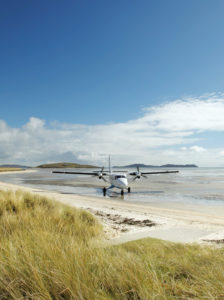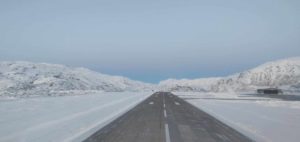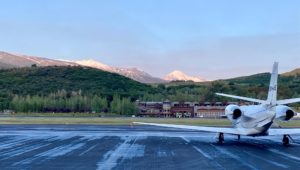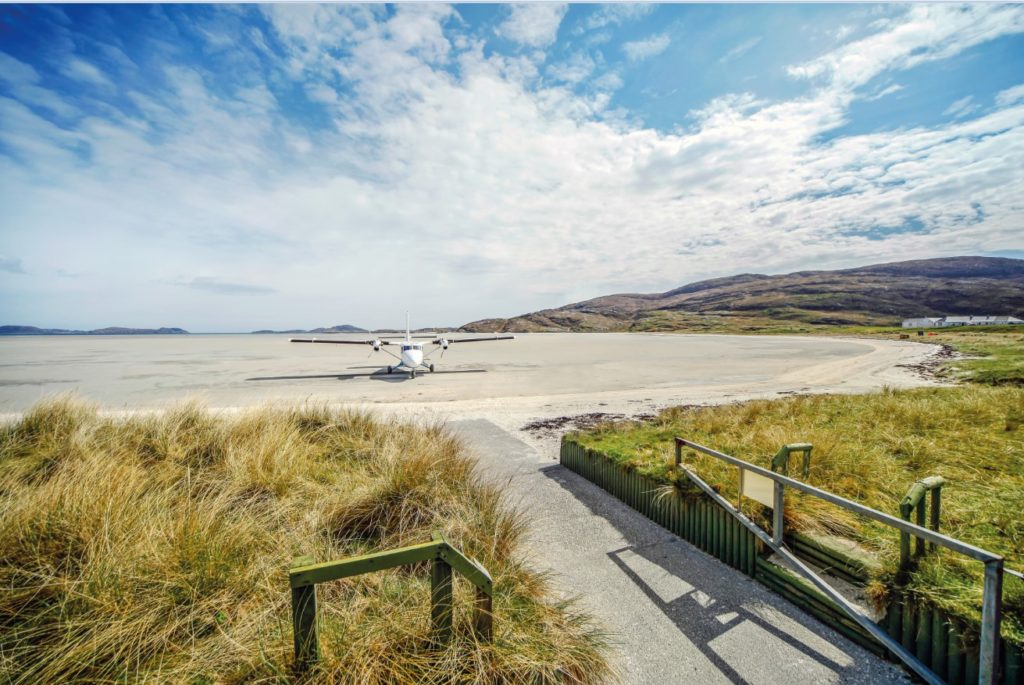When traveling, people are often so focused on the final destination, they don’t take the time to appreciate their surroundings. Although arriving at an airport, for the most part, is seldom a memorable event there are some rare gems around the world that deserve recognition for being truly spectacular.
Barra Airport, Scotland

Located at the North end of the Isle of Barra, approximately 12 miles (20km) from the settlement of Castlebay, Barra Airport is approximately 140 miles (225km) from Glasgow Airport. Over the summer months the airport deals with approximately 1,440 passengers and annually, just under 15,000.
“Barra Airport is the only airport in the world that operates scheduled landings and departures from beach runways – Traigh Mhor,” explains Michael Galbraith, Barra Airport manager. “The beach is our landing strip, and the sands on the beach and surrounding areas are a stunning white, with turquoise seas.”
Aircraft arrival and departure times at Barra Airport are dictated by the tide. A beach/runway inspection is carried out before any aircraft movements.
“We have three licensed runways, but there are no runway markings on the beach to indicate them. For the approach to Runway 25, you may experience wind shear from a nearby hill when the wind speed is above 25kts,” says Galbraith. “We suggest that only light aircraft with fixed undercarriage and propeller type engine aircraft land at Barra.”
Despite the unusual runway, no special training programs or certification is required for pilots who wish to land at the airport. “However, if they contact the flight information services officer aerial photographs of the field can be emailed so the pilot can get an overview of the terrain. New pilots coming into Barra for the first time are encouraged to do a flyover of the beach to get a general feel for it and the runway directions,” says Galbraith.
Some pilots landing at Barra airport find it difficult to distinguish areas of standing water from the receding tide. Galbraith says, “Pilots must become visual of the beach/runway before making a landing attempt. Weather and tide reports are also passed onto pilots prior to them departing.
“Very occasionally even spotting the correct beach can be a bit tricky.”
London City Airport, UK

“Situated along the scenic River Thames in the heart of East London, the airport offers unparalleled views of iconic landmarks such as the Tower of London and Canary Wharf,” says Chris Clayton, commercial manager, Private Jet Centre, London City Airport.
“This creates a striking contrast between urban excitement and a riverside setting that sets us apart from other airports.
“Whether it is your first time flying across London or your hundredth, each glimpse of the iconic sights and landmarks upon arrival and departure is a reminder of the city’s majesty and rich history,” Clayton adds.
Unlike most, London City Airport maintains a glide path set at 5.5 degrees. Pilot’s have to navigate several challenges during the landing process due to the airport’s urban location and specific geographic characteristics.
“The airport’s shorter runway length and the presence of surrounding buildings create a demanding approach angle, requiring a steeper descent rate than other airports,” says Clayton. “The proximity to the River Thames and the requirement for precise maneuvering further contribute to the complexity of landings.
“These factors demand heightened attention and skill from a pilot to ensure safe approaches and landings in variable weather conditions.”
Clayton advises, “Embrace the breathtaking scenery and enjoy the challenge! Additionally, prepare to meet our fantastic FBO team, who eagerly await your arrival with a warm smile and all the assistance you may need.”
Juancho Yrausquin Airport, The Dutch Caribbean
 Located on the Dutch Caribbean Island Saba, Juancho Yrausquin Airport has the shortest commercial runway in the world at only 400m (1,312ft) long. “When a traveler first looks out of the airplane window while approaching Saba, they’ll witness the sight of Mountain Scenery’s peak down to the shoreline. The panoramic view includes houses dotting the hillsides and meandering roads that ascend from the airport,” says Juancho Yrausquin Airport’s manager Maegan Hassell.
Located on the Dutch Caribbean Island Saba, Juancho Yrausquin Airport has the shortest commercial runway in the world at only 400m (1,312ft) long. “When a traveler first looks out of the airplane window while approaching Saba, they’ll witness the sight of Mountain Scenery’s peak down to the shoreline. The panoramic view includes houses dotting the hillsides and meandering roads that ascend from the airport,” says Juancho Yrausquin Airport’s manager Maegan Hassell.
“The airport provides charming vistas of hills and coastlines. Saba’s airport embodies the allure of the island.”
“With a length of only 400m, the runway has steep cliffs at both ends, leading directly into the ocean, leaving little room for any errors,” she explains. “Complicating matters further, crosswinds pose a continuous challenge, sometimes resulting in flight cancellations.”
At the present time, there are no formal written limits or restrictions in place concerning the types of aircraft capable of landing safely.
“The aircraft commonly used for Saba flights include BN2 Islanders and Twin Otters. Nevertheless, the authorization to operate within Saba’s airspace is exclusively granted to specific fixed-wing operators who have received approval from the regulator.”
The airport remains accessible for public helicopter operations and Hassel says it is vital to familiarize yourself with the features of the airport’s runway before flying to Saba.
“Understanding these factors is crucial for a safe landing. Remember, landing at our airport requires skill, preparation, and a keen understanding of the conditions. Your experience and adaptability will play a crucial role in ensuring a safe and successful landing,” she says.
Narsarsuaq Airport, Greenland
 Narsarsuaq Airport is in Southern Greenland, deep in one of the country’s many fjords. Originally built during WW2 as a refueling base for military aircraft, it has since been used as a civilian airport.
Narsarsuaq Airport is in Southern Greenland, deep in one of the country’s many fjords. Originally built during WW2 as a refueling base for military aircraft, it has since been used as a civilian airport.
Morten Rasmussen, aerodrome flight information service officer at Narsarsuaq Airport says, “A lot of people are surprised at just how green it is here, especially during the summer. The surroundings are very dramatic with high peaks, greenery, small patches of forest, icebergs in the fjords and the white icecap close by.”
Rasmussen describes the terrain at Narsarsuaq as “quite scary”, especially for the first few approaches. But the most challenging aspects for pilots landing at Narsarsuaq Airport is the weather.
“It can change very fast in this area and what seemed like good weather when you departed might be very different when you arrive,” says Rasmussen.
“We have a phenomenon called Föhn-wind during late fall and winter. Without warning the wind can go up to 80 knots along with an increase in temperature, often from -10°C to +10°C in just 15 minutes.”
The rise in temperature causes snow to melt rapidly. When the temperature eventually drops, it refreezes.
“Everything gets covered in thick, hard ice – including the runway. Sometimes it takes days to get rid of the ice and the airport closes for all operations for safety reasons.”
However, Narsarsuaq is generally known to be easy to pass through. “Just notify us on when you plan to arrive, have all the paperwork regarding fueling and payment done before you get here and enjoy your trip,” says Rasmussen.
Aspen/Pitkin County Airport, Colorado, USA

The Aspen/Pitkin County Airport is located in the southeastern end of the Roaring Fork Valley, which stretches from Glenwood Springs, Colorado at the northwest to the City of Aspen in the southeast.
“The facility is situated on a relatively flat valley floor surrounded on three sides by Aspen Mountain, Smuggler Mountain, and Red Mountain,” says Dan Bartholomew, the airport director for Aspen/Pitkin County Airport.
The terrain includes valleys, tree-lined mountain slopes and rapidly flowing rivers. “A highlight is the spectacular views offered of the most photographed location in Colorado, the Maroon Bells Wilderness Area. These massive 14,000ft peaks are located approximately 10 miles west of the airfield,” he says.
Altitude, terrain, wind conditions, weather, airfield conditions and operational procedures all offer challenges to pilots operating at the airport.
Aspen/Pitkin is the second highest commercial airport in the USA at 7,839ft above sea level. “Warm summer days can induce a density altitude of over 10,000ft. The effects of elevation on aircraft performance can be very surprising to pilots,” Bartholomew says.
The local topography is very complex, can be difficult to navigate and is often underestimated. Missed approaches, go-arounds, and baulked landing can be even more difficult because of the proximity of the high terrain in the area.
“Pilots should always have their missed approach procedures factored in before attempting to approach the airport,” Bartholomew says.
Aircraft operators should anticipate fast changing weather conditions and be prepared to respond as needed. The reduced taxiway to runway centerline separation means the airport is restricted to aircraft with wingspans 95ft or less.





